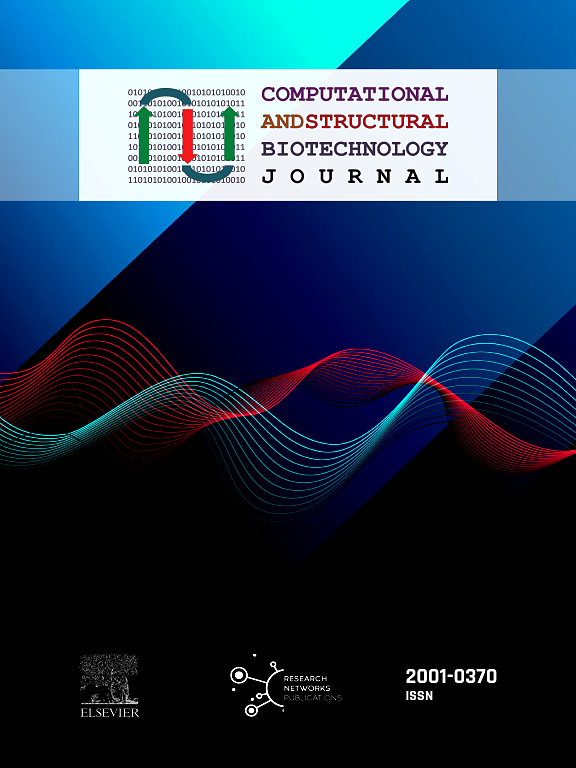术中对中枢神经系统肿瘤标记物进行快速扩增子测序
IF 4.4
2区 生物学
Q2 BIOCHEMISTRY & MOLECULAR BIOLOGY
Computational and structural biotechnology journal
Pub Date : 2024-11-08
DOI:10.1016/j.csbj.2024.11.007
引用次数: 0
摘要
目前,中枢神经系统肿瘤的诊断采用组织病理学检查与分子基因图谱分析相结合的综合诊断方法,这种方法需要数天至数周的时间才能对中枢神经系统肿瘤进行精确、翔实的分类。这项研究证明了快速多重扩增片纳米孔测序的可行性,它能在标准切除手术的时间范围内鉴定与脑肿瘤分子分层相关的关键突变。利用对纳米孔测序数据的实时分析,我们评估了脑肿瘤相关分子标记物IDH1 R132、IDH2 R172、pTERT C228和C250、H3F3A K27和G34、Hist1H3B K27和BRAF V600。我们的方法在护理点实现了从接收肿瘤活检到得出结果 105 分钟的周转时间,有可能对手术策略产生影响。我们的方法可以与最近开发的基于DNA甲基化的诊断分类系统相结合,从而确证诊断结果,甚至进一步明确肿瘤的分级,从而实现中枢神经系统恶性肿瘤的多模式术中诊断评估。本文章由计算机程序翻译,如有差异,请以英文原文为准。
Rapid intraoperative amplicon sequencing of CNS tumor markers
Currently, central nervous system tumors are diagnosed with an integrated diagnostic approach that combines histopathological examination with molecular genetic profiling, which requires days to weeks to achieve a precise and informative classification of CNS tumors. This study demonstrates the feasibility of rapid multiplex amplicon nanopore sequencing for identifying critical mutations relevant to molecular stratification of brain tumors within the timeframe of standard resection surgery. Utilizing live analysis of nanopore sequencing data, we evaluated the brain tumor-associated molecular markers IDH1 R132, IDH2 R172, pTERT C228 and C250, H3F3A K27 and G34, Hist1H3B K27, and BRAF V600. Our method achieved a turnaround time of 105 min at the point-of-care from receipt of a tumor biopsy to result with the potential to impact surgical strategy. Our approach can be integrated with recently developed DNA methylation-based diagnostic classification systems, corroborating diagnoses and even further specifying tumor grades, thus enabling a multimodal diagnostic intraoperative assessment of CNS malignancies.
求助全文
通过发布文献求助,成功后即可免费获取论文全文。
去求助
来源期刊

Computational and structural biotechnology journal
Biochemistry, Genetics and Molecular Biology-Biophysics
CiteScore
9.30
自引率
3.30%
发文量
540
审稿时长
6 weeks
期刊介绍:
Computational and Structural Biotechnology Journal (CSBJ) is an online gold open access journal publishing research articles and reviews after full peer review. All articles are published, without barriers to access, immediately upon acceptance. The journal places a strong emphasis on functional and mechanistic understanding of how molecular components in a biological process work together through the application of computational methods. Structural data may provide such insights, but they are not a pre-requisite for publication in the journal. Specific areas of interest include, but are not limited to:
Structure and function of proteins, nucleic acids and other macromolecules
Structure and function of multi-component complexes
Protein folding, processing and degradation
Enzymology
Computational and structural studies of plant systems
Microbial Informatics
Genomics
Proteomics
Metabolomics
Algorithms and Hypothesis in Bioinformatics
Mathematical and Theoretical Biology
Computational Chemistry and Drug Discovery
Microscopy and Molecular Imaging
Nanotechnology
Systems and Synthetic Biology
 求助内容:
求助内容: 应助结果提醒方式:
应助结果提醒方式:


